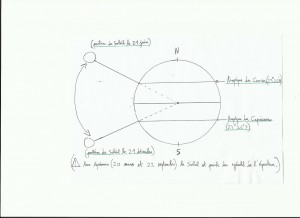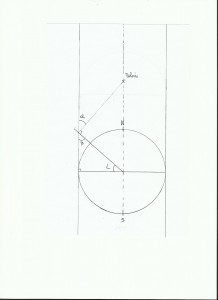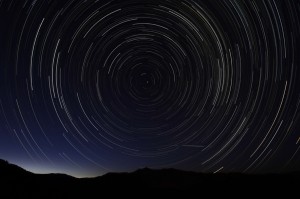Today with the use of GPS navigation has been greatly simplified, we are able to know every time our position about few meters. But it is always fun and entertaining to know our position with the sky too, provided that of course not to be bothered by clouds!
1)The sun
The sun's path relative to the earth is easy, during the day it rises at the east side and fall at the West side roughly(it rises in the east and falls in the west with the best accuracy at the equinoxes, the rest of the time it is not exactly correct), and during the year the sun oscillates between 2 tropics. At the summer's solstice the sun is at the zenith of the Cancer's tropic(at a latitude of about 23 ° 26'N)and at the winter solstice it is almost above the Capricorn's tropic(latitude 23°26’S). At equinoxes the sun is near the zenith of the equator. Small diagram!
(this is not really a work of art, but well…)
During the day the sun describes an inverted parabola in the sky, it peaks at noon(the local noon of the observer). For example, if an observer has a watch adjusted in UT time(hours of Greenwich)he will normally see the sun peaking at noon if he is at Greenwich or on Greenwich meridian. If the same observer is placed eastward from Greenwich the sun will peak sooner, and if he goes westward from Greenwich this observation will come later.
We can therefore deduce a method to find the South or the North at 5 ° or 10 ° of accuracy, it's valid in temperate areas(between 23 ° 26′ and 66 ° 34′ South or North):
.Adjust your watch in time UT.
.In the Northern Hemisphere we point hours needle at the sun and the south will be indicated by bisector's angle made between this needle and twelve hour's direction 12. In the southern hemisphere the principle is the same but the number 12 of the watch has to be pointed at the sun, North is located halfway between the 12 and the hour hand(In both cases we don't use minutes hand).
The watch serves a little here as a compass (if you have a watch with a digital display it's the mess).
Notice: in temperate areas at local noon the sun indicates the south in the northern hemisphere and the north in south hemisphere.
2)The North Star(Polaris )
In the northern hemisphere there is a very useful star to find the north and our latitude, it's Polaris. On the celestial vault it's the only one which is motionless. It is found easily because it is located between the great bear and Cassiopeia. Small diagram!
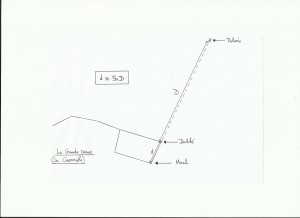 When you keep an eye on the great bear's pan, if you use the edge which is opposed to the pan's handle(the star Dubhe and Merak), you have just to multiply by 5 the distance between these two stars while maintaining alignment to fall on Polaris, so the North.
When you keep an eye on the great bear's pan, if you use the edge which is opposed to the pan's handle(the star Dubhe and Merak), you have just to multiply by 5 the distance between these two stars while maintaining alignment to fall on Polaris, so the North.
Use of a sextant and making a measurement of Polaris height above the horyzon, and you will know your latitude on earth(after several attempts the margin of error between my real latitude and latitude found with this method has never exceeded 30 minutes, this margin may vary up to 1 °I think). Small diagram!
Here, Beta angle = 90 °-L, so Alpha=180°-(90° Bêta). So Alpha=L=latitude. Polaris is very far from us(can be considered almost to infinity), its light rays received from the land are parallel.
3)The moon
If the moon rises after midnight(when it decreases), side illuminated by the sun will be at the East; if it rises before the sunset its lighted side will show the West(when it grows). A little mnemonic: “in the northern hemisphere, the moon lies. In the southern hemisphere it does not lie.” It simply means that in our latitudes when the Moon cgrows it has the shape of a D, and when it dshrinks it forms a C. Attenzione, draw!
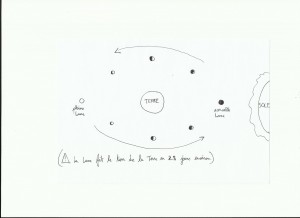 (I want to thank the kindergarten which has provided this drawing!)
(I want to thank the kindergarten which has provided this drawing!)
Notice: when the Moon is shaped like a croissant, if the alignment is extended from both ends of this croissant with a straight line, the intersection of this line with the horyzon gives the South direction roughly.
4)Stars
As noted above in the sky only the polar star is relatively motionless(in the northern hemisphere). Earth turning on itself, so we have the illusion in our earthly referential that it's all the celestial vault which is turning around Polaris anticlockwise(the vault rotates clockwise in the Southern Hemisphere). We can deduce that in the Northern Hemisphere:
.If you see a star move to the right it tells us about the South
.If you see a star moving to the left it is the North
.If the star rises it's east
.If it falls it is the West
(in the Southern Hemisphere it is the contrary)
In fact during the night stars will turn around Polaris like this:
